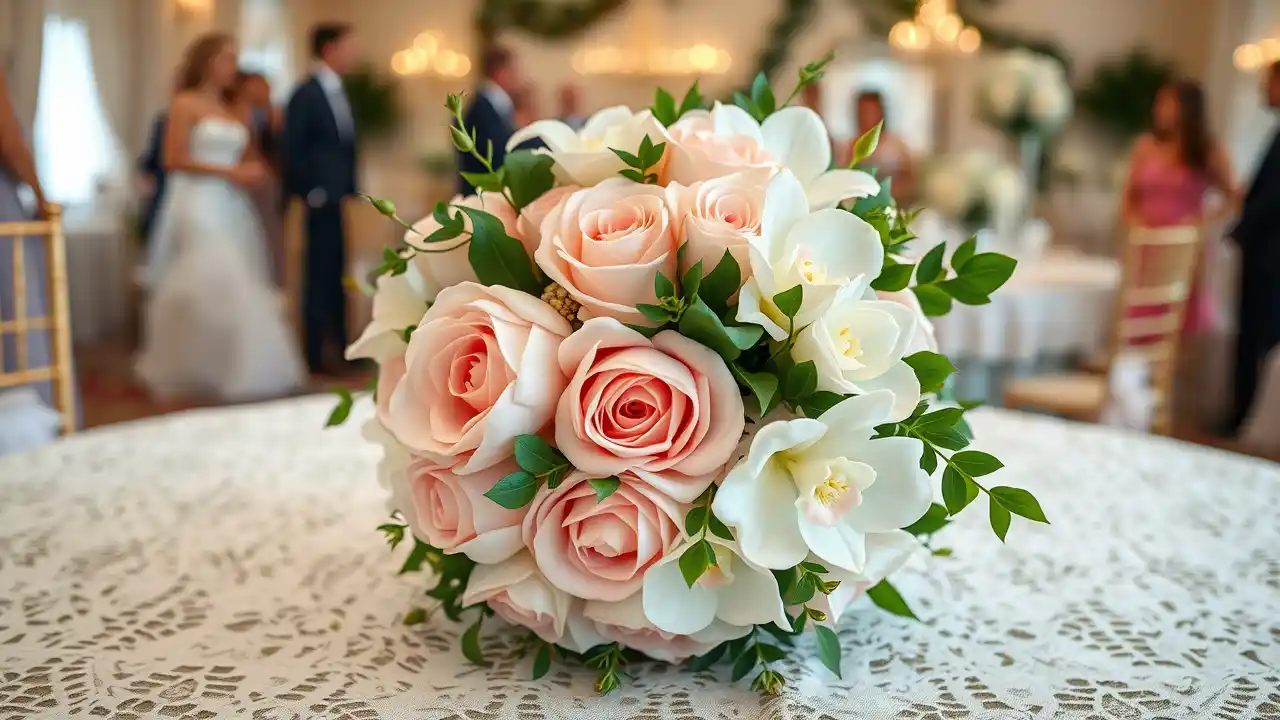This comprehensive guide walks you through everything you need to know about wedding bouquets—from timeless classics to bold contemporary statements. Whether you’re planning an intimate garden ceremony or a grand ballroom celebration, your bouquet serves as both a personal fashion statement and a living piece of wedding tradition.
Contents
- Introduction to Wedding Bouquets
- Popular Types of Wedding Bouquets
- Top Flowers for Wedding Bouquets
- Color Palettes and Themes
- Seasonal Wedding Bouquets
- Budget-Friendly Wedding Bouquet Ideas
- Wedding Bouquets Accessories and Enhancements
- Cultural and Regional Wedding Bouquets Styles
- Wedding Bouquet Trends for 2024
- Tips for Choosing the Perfect Wedding Bouquet
Introduction to Wedding Bouquets
What is a Wedding Bouquet?
At its simplest, a wedding bouquet is a carefully arranged collection of flowers carried by the bride and often her attendants. Yet this definition barely scratches the surface of what these arrangements truly represent.
The modern wedding bouquet traces its origins to ancient Rome, where brides carried herbs and spices—not for beauty, but to ward off evil spirits and symbolize fertility. Today’s wedding bouquets have evolved into sophisticated design elements that complement the bride’s overall aesthetic while honoring centuries of tradition.
“The bouquet is often the last piece chosen in the bridal styling puzzle, but it’s the one element that ties everything together,” notes celebrity florist Philippa Craddock, whose clients include members of the British royal family. “It connects the bride’s vision to the venue’s atmosphere and the season’s essence.”
Importance of Wedding Bouquets in Bridal Style
The perfect bouquet doesn’t merely accent a wedding dress—it completes it. Consider the visual impact: a cascade of orchids dramatically extending the lines of a sleek sheath gown, or a compact posy of garden roses softening the structured edges of a ballgown.
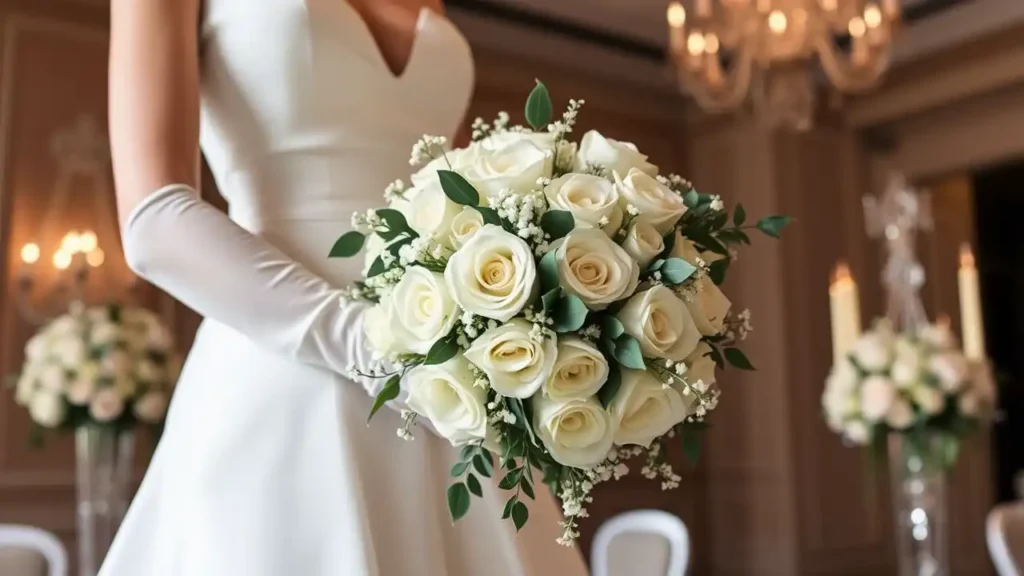
Your bouquet creates visual balance, introduces color theory to your ensemble, and literally puts your personal style within arm’s reach throughout your ceremony.
Fashion historians have long recognized that bridal bouquets serve as the ultimate accessory. “Where jewelry remains static, bouquets bring movement, texture, and life to bridal fashion,” explains wedding historian Elizabeth Currid-Halkett. “They’re the only element of bridal style that engages all the senses.”
How Bouquets Reflect Wedding Themes and Personalities
Your choice of flowers speaks volumes. The bride who selects tight, uniform roses in immaculate white signals different priorities than one who opts for loosely gathered wildflowers tied with raw silk ribbon.
Jennifer Myers, a psychologist specializing in wedding planning stress, notes: “I often ask clients to select their ideal bouquet as an exercise in clarifying their true wedding vision. It’s remarkable how often this single choice illuminates their authentic style preferences better than multiple Pinterest boards.”
Consider how these bouquet choices reflect different personality types:
- The structured perfectionist: Symmetrical arrangements with uniform blooms
- The romantic dreamer: Loose, garden-inspired designs with trailing ribbons
- The modern minimalist: Single-variety bouquets or architectural arrangements
- The bohemian spirit: Wildflower collections with unexpected elements
- The traditional classicist: Timeless roses with subtle personalization
Popular Types of Wedding Bouquets
Classic Styles
Round Wedding Bouquets
Nothing says timeless quite like the perfectly spherical bouquet. This classic dome-shaped arrangement gained prominence during the Victorian era and remains the gold standard for formal weddings. Typically composed of tightly packed blooms of similar size, the round bouquet creates a sense of order and symmetry.
What makes this style endure across decades? Its universally flattering proportions. “The round bouquet works with virtually any dress silhouette,” explains bridal stylist Carmen Liu. “It’s particularly effective for petite brides who might be overwhelmed by larger arrangements.”
Cascade Wedding Bouquets
Dramatic. Romantic. Unforgettable. The cascade bouquet—sometimes called a waterfall bouquet—features flowers that flow downward from the main arrangement, creating a vertical dimension that draws the eye. Princess Diana’s spectacular trailing arrangement of gardenias, stephanotis, and orchids sparked a cascade renaissance in the 1980s, though today’s versions typically feature a more controlled flow.
“The modern cascade works because it creates movement without excess volume,” notes florist Sebastian Flowers. “We’re seeing brides choose delicate trailing elements like jasmine vine or amaranthus rather than dense floral cascades.”
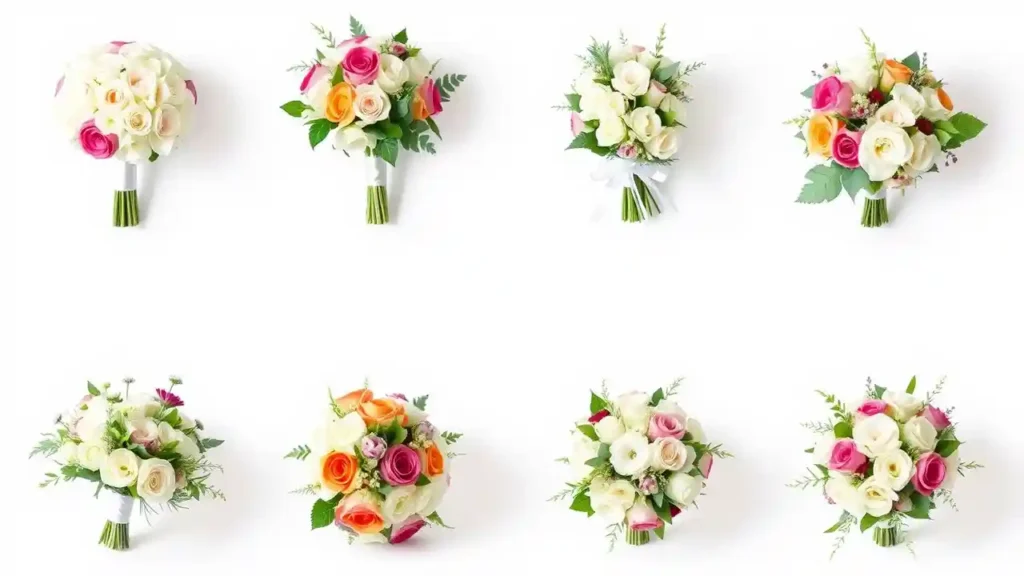
Hand-Tied Bouquets
There’s something undeniably intimate about hand-tied bouquets. These arrangements—gathered as if freshly picked from a garden and bound with ribbon or twine—strike the perfect balance between structured and organic. The exposed stems create a natural, unaffected aesthetic that photographs beautifully.
What distinguishes a truly exceptional hand-tied bouquet isn’t just the flower selection but the binding technique. “A proper hand-tied spiral requires each stem to be placed at precisely the same angle,” explains master florist Catherine Muller. “When executed correctly, the bouquet can stand upright on its own stems—a test of proper technique.”
Modern Styles
Minimalist Wedding Bouquets
In an era of design restraint, the minimalist bouquet makes a compelling statement through simplicity. These arrangements often feature a single flower variety or monochromatic color palette, allowing texture and form to take center stage. Think three perfectly opened peonies or a small cluster of calla lilies, their stems wrapped in fine leather cord.
The psychological impact of these streamlined arrangements shouldn’t be underestimated. “Minimalist bouquets create negative space—visual breathing room that allows both the flowers and the bride to shine without competition,” observes wedding photographer James Christianson.
Oversized Bouquets
At the opposite end of the spectrum, maximalist oversized bouquets have surged in popularity, particularly for statement wedding photoshoots. These substantial arrangements—sometimes spanning two feet in diameter—create a dramatic focal point and instant visual impact.
“The oversized bouquet works when it maintains a sense of artful proportion,” cautions celebrity florist Jeff Leatham. “The goal isn’t simply ‘bigger’; it’s about creating an arrangement that frames the bride’s face and complements her stature.”
Flower Hoop Bouquets
Perhaps the most Instagram-worthy contemporary trend, the flower hoop reimagines the traditional bouquet as a circular wreath held in one hand. Typically constructed on a metal or wooden hoop base, these arrangements can range from minimally adorned circles to fully embellished wheels of flowers.
Wedding planner Laurie Arons notes their practical advantages: “Hoop bouquets allow freedom of movement that traditional bouquets don’t. For brides who want to interact more freely during their ceremony—holding hands with children or elderly relatives—these bouquets solve a real logistical challenge.”
Unique Wedding Bouquets Styles
Dried Flower Bouquets
The sustainability movement has propelled dried flower bouquets from bohemian alternative to mainstream option. Today’s dried arrangements bear little resemblance to the dusty preserved flowers of decades past—instead featuring naturally preserved blooms, bleached foliage, and textural elements like pampas grass and bunny tails.
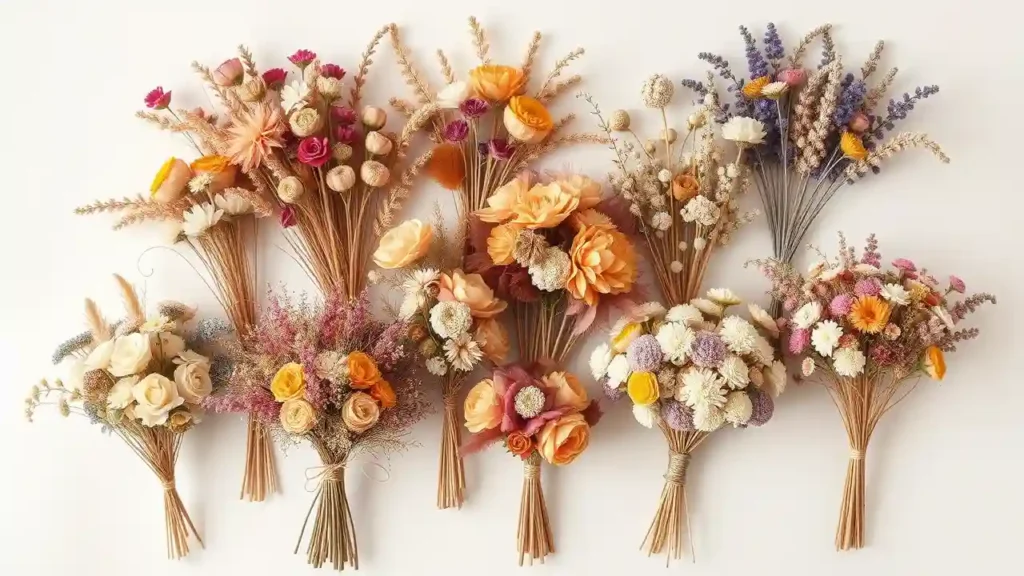
Beyond their eco-friendly credentials, dried bouquets offer practical advantages. “For destination weddings, dried arrangements eliminate the stress of wilting flowers in transit or extreme climates,” explains destination wedding specialist Alison Johnson. “They also become instant keepsakes without requiring preservation.”
Succulent Bouquets
Hardy, geometric, and undeniably distinctive, succulent-focused bouquets have carved out a dedicated following among modern brides. These arrangements typically incorporate traditional flowers alongside echeveria, aeonium, and other sculptural succulents.
The real advantage? Post-wedding potential. “Most succulents used in bouquets can be planted afterward,” notes sustainable wedding advocate Terra Smith. “I’ve had clients create entire garden beds from their wedding flowers—living mementos that continue growing alongside their marriage.”
Non-Traditional Bouquets
For the bride who says “flowers aren’t really my thing,” alternative bouquets offer endless creative possibilities. Recent years have seen the rise of bouquets made from family heirloom brooches, origami paper flowers, vintage book pages, seashells, feathers, and even intricately arranged vegetables for chef brides.
“The most successful alternative bouquets honor the tradition while reflecting authentic personal interests,” observes wedding trend analyst Keisha Williams. “They should never feel gimmicky—they should feel like a natural extension of the bride’s identity.”
Top Flowers for Wedding Bouquets
Timeless Choices
Roses
The undisputed monarch of wedding flowers, roses have adorned bridal bouquets for centuries—and with good reason. With approximately 150 varieties commercially available, roses offer unparalleled versatility in color, size, and fragrance. From the tightly packed petals of garden roses to the delicate silhouette of spray varieties, these blooms provide texture and dimension while carrying deep romantic symbolism.
Worth noting: not all roses are created equal. “Garden roses cost significantly more than standard varieties, but their superior fragrance and complex petal patterns make them worth the investment for bouquets, where they’ll be closely observed,” advises floral economist Michael Chase.
Peonies
With their lush, voluminous blooms and intoxicating fragrance, peonies have achieved near-mythical status in wedding floristry. Their limited seasonal availability (typically May through early July in the Northern Hemisphere) only enhances their desirability, with brides often scheduling wedding dates around peony season.
“The beauty of peonies lies in their transformative nature,” explains botanical illustrator Sarah Winward. “A barely opened peony bud in the morning becomes a magnificent open bloom by reception time, creating an ever-evolving bouquet.”
Calla Lilies
Architectural, sophisticated, and inherently elegant, calla lilies stand apart from more traditional wedding blooms. Their smooth, sculptural form makes them particularly well-suited to modern and minimalist wedding aesthetics, while their available color range—from pure white to deep burgundy—offers versatility across different palettes.
Floral designer Ariella Chezar notes their practical advantages: “Callas withstand handling remarkably well, maintain their striking appearance throughout the day, and don’t shed pollen that might stain bridal attire—practical considerations that matter tremendously.”
Trendy Picks
Ranunculus
With their delicate, multilayered petals and slender stems, ranunculus deliver the romantic look of roses with a distinctly contemporary twist. Available in an extraordinary range of colors—including unusual tones like coffee, dusty mauve, and butterscotch—these blooms have become the cornerstone of modern romantic bouquets.
“Ranunculus create textural dimension unlike any other flower,” notes floral designer Emily Thompson. “Their paper-thin petals capture light differently throughout the day, creating subtle shifts in color as the wedding progresses.”
Anemones
Graphic, bold, and instantly recognizable, anemones have become the statement flower for fashion-forward brides. Their striking contrast—typically dark centers surrounded by crisp white or jewel-toned petals—creates visual drama that photography captures beautifully.
Wedding photographer Jose Villa explains their appeal: “Anemones provide natural visual anchors in bouquet compositions. Their defined centers draw the viewer’s eye and create focal points that make bouquet photos particularly compelling.”
Proteas
Nothing communicates “I made a distinctive floral choice” quite like incorporating proteas into your wedding bouquet. These structural blooms—with their otherworldly shapes and impressive longevity—have transcended their trendiness to become modern classics for brides seeking something extraordinary.
“Proteas symbolize diversity and courage,” explains floral symbolist Maria Chen. “They’re increasingly chosen by brides who want their florals to communicate personal values alongside aesthetic preferences.”
Seasonal Flowers
Spring: Tulips, Lilacs
Spring brides enjoy access to some of the year’s most exquisite blooms. Tulips—available in over 3,000 registered varieties—offer ruffled, fringed, and parrot options far beyond the standard single forms. Fresh lilacs bring incomparable fragrance but require careful handling; their delicate nature means they’re best incorporated into bouquets immediately before the ceremony.
“What makes spring flowers special is their sense of natural movement,” observes Dutch master florist Menno Kroon. “Their stems often have gentle curves that create dynamism in arrangements that florists working with other seasonal blooms must artificially create.”
Summer: Sunflowers, Dahlias
Bold, abundant, and full of personality, summer flowers bring vibrant energy to wedding bouquets. Dahlias deserve special attention for their remarkable diversity—from tiny button varieties to dinner-plate blooms exceeding 10 inches in diameter, offering endless design possibilities.
Floral preservationist Leigh Shepard notes: “Summer bouquets typically preserve beautifully because their flowers have naturally higher moisture content. Brides planning to preserve their arrangements should consider this seasonal advantage.”
Fall: Chrysanthemums, Marigolds
Autumn wedding bouquets celebrate rich color and unusual textures. Contemporary florists have completely reimagined chrysanthemums, incorporating specialty varieties like spider mums and quilled forms that bear little resemblance to their common counterparts. Marigolds—once considered strictly garden flowers—have entered the luxury wedding space through elevated varieties with complex petal patterns.
“Fall bouquets benefit from incorporating seasonal elements beyond flowers,” suggests botanical stylist Nina Parker. “Integrating heirloom pumpkin stems, specialty ferns, or foraged mushrooms creates arrangements that truly capture the season’s essence.”
Winter: Amaryllis, Evergreens
Winter weddings call for flowers with presence and fortitude. Amaryllis blooms—with their impressive size and regal bearing—create instant impact in bridal bouquets. When paired with textural evergreens, berries, and forced flowering branches, they create arrangements of uncommon sophistication.
“Winter wedding bouquets should engage multiple senses,” advises sensory floral designer Julian Winters. “Incorporating fragrant eucalyptus, rosemary, or cedar engages the olfactory experience when fewer naturally scented flowers are available.”
Color Palettes and Themes
Classic Colors
White and Ivory
The enduring appeal of all-white bouquets lies in their timeless elegance and symbolic purity. Far from being one-dimensional, white bouquets showcase subtle tonal variations—from creamy ivory to crisp snow white—that create surprising depth and dimension.
“The success of a white bouquet depends entirely on texture,” emphasizes White House floral designer Laura Dowling. “Without color variation, the arrangement must rely on contrasting petal structures, varying bloom sizes, and strategic incorporation of different floral forms to create visual interest.”
Pastels (Pink, Blush, Lavender)
Soft, romantic, and universally flattering, pastel bouquets complement virtually any wedding palette. These gentle hues—particularly flattering in natural light photography—create an ethereal quality that enhances the bride’s natural luminosity.
Color psychologist Jennifer Bourn observes: “Pastel bouquets create an optical softening effect in photographs. The gentle color reflection subtly illuminates the bride’s features—one reason these palettes remain consistently popular despite changing trends.”
Bold and Vibrant
Red, Burgundy
Nothing makes a statement quite like a bouquet in rich, saturated red. Whether featuring classic roses or unexpected elements like dahlias and ranunculus, red bouquets communicate confidence and passionate romance. Burgundy arrangements introduce sophisticated depth, particularly effective for fall and winter weddings.
“Bold bouquets require thoughtful dress pairing,” advises bridal stylist Thomas Beaman. “They work beautifully against stark white gowns where they create dramatic contrast, but can compete with ivory or champagne dresses that have warmer undertones.”
Jewel Tones (Emerald, Sapphire)
Rich, saturated, and undeniably Luxury Bouquets have gained remarkable popularity for evening and winter weddings. These deep, vibrant hues—emerald green, sapphire blue, amethyst purple—create richly dimensional arrangements that photograph with particular intensity.
“Jewel tones create a fascinating perceptual effect,” notes color theorist Samantha Lee. “They appear to change depth and intensity under different lighting conditions throughout the day, creating bouquets that seem almost animated as they transition from natural daylight to evening reception lighting.”
Themed Bouquets
Rustic Wedding Bouquets (Greenery, Wildflowers)
The enduring popularity of rustic wedding themes has elevated formerly overlooked botanical elements to starring roles. Today’s elevated rustic bouquets incorporate heirloom garden varieties, locally foraged elements, and specialty grasses with artful restraint.
“What distinguishes sophisticated rustic bouquets from their more literal counterparts is curation,” explains farm-to-table florist Sarah Davidson. “Rather than including every available wildflower, thoughtful selection and color editing create rustic arrangements with clear design intention.”
Bohemian Wedding Bouquets (Mixed Textures, Dried Elements)
Bohemian bouquets embrace natural imperfection and unexpected combinations. These free-spirited arrangements often incorporate diverse elements—fresh and dried flowers, grasses, pods, and even feathers—unified through a coherent color story rather than matching blooms.
Anthropologist and wedding trend analyst Dr. Livia Moore notes the cultural significance: “Bohemian bouquets represent a fascinating return to pre-Victorian floral traditions, when bouquets were less about uniform perfection and more about personal expression through meaningful botanical choices.”
Vintage Wedding Bouquets (Soft Hues, Antique Accents)
Vintage-inspired bouquets reference specific design periods through both flower selection and styling techniques. Whether channeling Art Deco geometry, Victorian language-of-flowers symbolism, or 1950s compact nosegays, these arrangements connect modern weddings to historical traditions.
“Authentic vintage bouquets require historical knowledge,” advises floral historian Elizabeth Murray. “The most successful examples demonstrate understanding of period-appropriate flower varieties, color combinations, and arrangement styles rather than simply applying a general ‘old-fashioned’ aesthetic.”
Seasonal Wedding Bouquets
Spring Wedding Bouquets: Fresh and Fragrant Blooms
Spring bouquets capture the essence of renewal. This season offers extraordinary variety, from early bulb flowers like hyacinths and muscari to spectacular flowering branches. Lily of the valley—Kate Middleton’s choice for her royal wedding bouquet—reaches its brief, glorious peak in spring, offering unmatched delicacy and fragrance.
“Spring bouquets benefit from incorporating flowering branches like quince, cherry, or apple blossom,” suggests botanical architect Todd Fiscus. “These elements create linear dimension while connecting the arrangement to the season’s natural flowering sequence.”
Summer Wedding Bouquets: Bright and Bold Arrangements
Summer bouquets celebrate abundance. With the widest selection of locally available flowers, summer brides can create virtually any design concept without relying heavily on imports. This season enables particularly successful color-blocking techniques, where distinct flower varieties in complementary hues create striking visual impact.
Environmental floristry advocate Bethany Shaw notes: “Summer allows for truly sustainable bouquet creation, with sufficient local variety to create sophisticated designs using flowers grown within 100 miles of most wedding venues.”
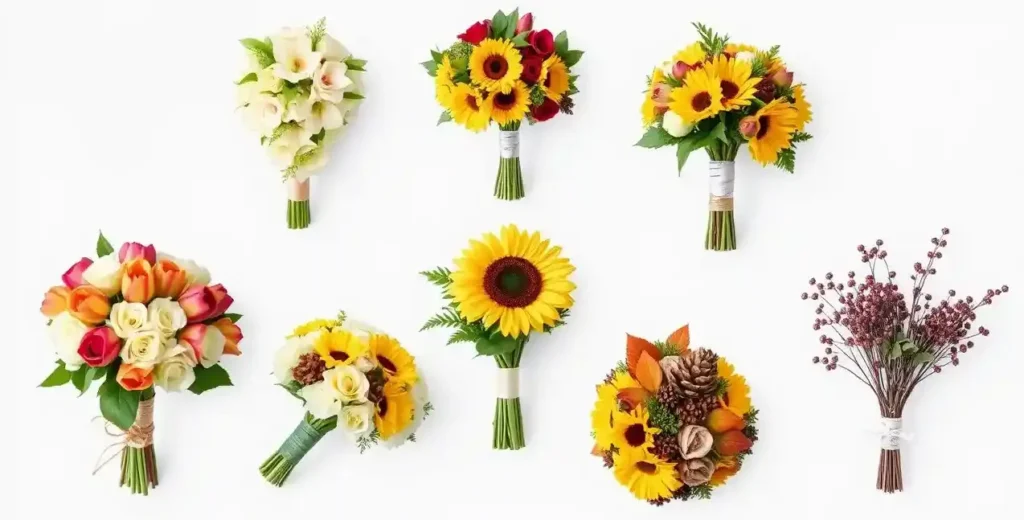
Fall Wedding Bouquets: Warm and Earthy Tones
Fall bouquets embrace rich color transformation. Beyond the expected burgundy and orange palette, contemporary autumn arrangements incorporate unexpected elements: chocolate cosmos, nearly-black dahlias, bronze chrysanthemums, and copper beech foliage create sophisticated seasonal statements.
“Fall offers unique opportunities for incorporating non-floral elements that create distinctive textural interest,” explains botanical stylist Marcus Thompson. “Artfully arranged seedpods, specialty grasses, and even preserved fruits create arrangements impossible in other seasons.”
Winter: Elegant and Evergreen Styles
Winter bouquets project strength and refinement. When designing for the season’s challenges, florists often incorporate unexpected tropical elements alongside seasonal standbys. Phalaenopsis orchids, anthuriums, and certain protea varieties provide sculptural forms that complement traditional winter greenery.
“Winter bouquets should incorporate reflective elements that maximize available light,” advises wedding photographer Christine Craig. “Silver brunia berries, eucalyptus with pronounced silver undersides, and certain dusty miller varieties create luminosity that enhances photos during the season’s limited daylight hours.”
Budget-Friendly Wedding Bouquet Ideas
Affordable Flower Options
Creating a stunning bouquet needn’t require rare, imported blooms. Numerous readily available flowers offer impressive visual impact at accessible price points:
- Carnations: No longer wedding wallflowers, specialty carnations (particularly antique varieties) provide exceptional texture and longevity.
- Chrysanthemums: Contemporary varieties bear little resemblance to their convenience store counterparts, offering complex forms and unusual colors.
- Stock: These architecturally impressive spikes provide both structural interest and intense fragrance.
- Alstroemeria: With two-week vase life and multiple blooms per stem, these flowers deliver exceptional value.
“The most budget-friendly approach isn’t choosing cheap flowers—it’s selecting seasonal, locally available blooms at their peak,” advises financial wedding planner Tessa Rodriguez. “This strategy simultaneously reduces costs and improves quality.”
DIY Wedding Bouquets
For the crafty bride, DIY bouquets offer both cost savings and personal satisfaction. Success requires advance planning:
- Practice at least three times before the wedding day
- Purchase 20% more flowers than you think you’ll need
- Prepare all flowers (removing excess foliage, thorns) the day before
- Use proper floral tape and pins to secure arrangements
- Keep arrangements hydrated until the last possible moment
“DIY bouquets work best when designed around forgiving flowers,” advises craft expert Michelle Davidson. “Avoid delicate blooms like gardenias or stephanotis that show damage quickly, and focus on hardier varieties like roses, lisianthus, and sunflowers.”
Silk and Artificial Bouquets
Today’s premium artificial flowers bear little resemblance to the plastic varieties of previous generations. High-end silk flowers—hand-painted and constructed with botanical accuracy—create surprisingly realistic arrangements that offer significant advantages:
- Perfect appearance regardless of weather conditions
- No allergy concerns for sensitive brides
- Opportunity to create arrangements months before the wedding
- Automatic keepsake without preservation costs
“Quality artificial arrangements typically cost 80% of what comparable fresh arrangements would,” notes wedding budget analyst Terrence Wu. “While not initially cheaper, their reusability for home décor post-wedding makes them economically advantageous.”
Repurposing Ceremony Flowers for Reception
Strategic flower planning creates opportunities for significant savings. Consider these approaches:
- Design ceremony arrangements in movable vessels that can be repositioned for reception décor
- Create bridesmaid bouquets that double as centerpiece components
- Arrange altar flowers in separate containers that can be reconfigured as buffet décor
- Use the bridal bouquet as the sweetheart table centerpiece during dinner
“The most effective flower repurposing requires incorporating this strategy into initial design conversations,” advises wedding planner Francesca Abbate. “When florists understand this intention from the beginning, they can create arrangements specifically engineered for dual purposes.”
Wedding Bouquets Accessories and Enhancements
Ribbons and Wraps
The finishing touch on any bouquet—its binding—significantly impacts the overall aesthetic. Contemporary options extend far beyond basic satin ribbon:
- Hand-dyed silk ribbon with frayed edges
- Heirloom lace from a family wedding dress
- Hand-lettered fabric bands with personal messages
- Woven textiles reflecting cultural heritage
- Leather wraps for modern, structural arrangements
“The bouquet wrap deserves the same aesthetic consideration as the flowers themselves,” emphasizes detail specialist Caroline Shaw. “This element appears prominently in photographs and carries significant design impact despite its relatively small surface area.”
Bouquet Jewelry (Charms, Pins)
Personalizing bouquets through meaningful embellishments creates emotional connections to arrangements. Consider these thoughtful additions:
- Vintage brooches from female relatives
- Memorial charms featuring departed loved ones
- Children’s artwork translated into custom pins
- Meaningful symbols (religious medallions, cultural emblems)
- Monogrammed or engraved metal accents
“Bouquet jewelry serves as a private touchpoint for brides during emotional ceremonies,” observes wedding psychologist Rebecca Martinez. “These talismans provide comfort and connection during moments of intense emotion.”
Adding Greenery and Foliage
Often overlooked, foliage selection dramatically impacts bouquet character. Beyond basic choices like eucalyptus and Italian ruscus, consider these distinctive options:
- Jasmine vine for trailing movement
- Fiddlehead ferns for structural interest
- Olive branches for Mediterranean influence
- Hosta leaves for impressive scale
- Dusty miller for color-softening effect
- Variegated pittosporum for visual complexity
“Foliage contributes approximately 60% of a bouquet’s visual structure but typically represents only 20% of its cost,” notes floral economist Jason Williams. “Investing in specialty greens often delivers greater visual impact than equivalent spending on premium blooms.”
Personal Touches (Photos, Heirlooms)
Incorporating meaningful mementos transforms bouquets into deeply personal keepsakes:
- Miniature framed photos attached to stems
- Fabric from significant garments wrapped around handles
- Family heirloom rosaries or prayer beads interwoven with flowers
- Charms made from wedding rings of departed relatives
- Letters or notes securely sealed in transparent lockets
“The most meaningful bouquet elements are often invisible to guests,” notes memorial floristry specialist Emma Richardson. “These private inclusions create emotional anchoring during ceremonies while remaining the bride’s personal secret.”
Cultural and Regional Wedding Bouquets Styles
Traditional European Bouquets
European bouquet traditions vary significantly by country and region:
- French: Structured, architectural arrangements emphasizing a single standout flower variety
- English: Garden-inspired designs with loose, natural forms and fragrant components
- Italian: Bold color statements featuring regional blooms like anemones and ranunculus
- Scandinavian: Minimalist compositions emphasizing negative space and seasonal simplicity
- German: Precise, technical arrangements with mathematical proportions and formal symmetry
“European bouquet traditions reflect broader cultural values,” observes wedding anthropologist Dr. Martina Schmidt. “The English country garden style reveals their reverence for natural landscapes, while French Wedding Bouquets demonstrate their appreciation for architectural precision.”
Asian-Inspired Designs
Asian floral traditions offer distinctive approaches to wedding bouquets:
- Japanese: Ikebana-inspired arrangements emphasizing negative space and asymmetrical balance
- Chinese: Lucky red bouquets incorporating symbolically significant flowers like peonies and orchids
- Korean: Artfully combined textures with meaningful numerical groupings (particularly 3s and 9s)
- Thai: Elaborate compositions incorporating carved elements and precise geometric forms
- Indian: Colorful, fragrant arrangements featuring marigolds, roses, and jasmine
“Asian bouquet traditions often prioritize symbolism over purely aesthetic considerations,” explains cultural wedding consultant Wei Zhang. “Understanding these symbolic meanings allows contemporary designers to create arrangements that honor tradition while embracing modern styling.”
Indian Wedding Bouquets (Floral Mandaps)
Indian wedding floristry extends far beyond bouquets to create immersive botanical environments. While traditional Indian ceremonies feature distinctive floral elements like garlands (jaimala) and headpieces, modern Indian brides increasingly incorporate Western-style bouquets alongside traditional components.
“Contemporary Indian wedding bouquets often feature fusion elements,” notes multicultural wedding specialist Priya Patel. “We’re seeing traditional flowers like marigolds and jasmine arranged in Western cascade styles, creating cross-cultural statements that honor both heritage and global influences.”
Tropical and Beach-Themed Bouquets
Destination weddings have elevated tropical bouquet design beyond basic paradise clichés. Today’s sophisticated tropical arrangements might feature:
- Uncommon varieties like torch ginger and rainforest proteas
- Indigenous blooms specific to the wedding location
- Architecturally dramatic foliage like split-leaf philodendron
- Carefully preserved coral elements (sourced ethically)
- Local fruits incorporated as botanical elements
“The most successful tropical bouquets demonstrate environmental awareness,” advises destination wedding specialist Maria Suarez. “Using locally grown flowers not only reduces carbon footprint but also creates arrangements uniquely specific to your wedding location.”
Wedding Bouquet Trends for 2024
Dried and Preserved Flowers
The preserved flower renaissance continues its momentum, with techniques extending far beyond simple air-drying:
- Glycerin-preserved foliage maintaining flexible texture
- Freeze-dried blooms retaining three-dimensional form
- Bleached botanical elements creating monochromatic statements
- Color-enhanced preserved flowers achieving impossible natural hues
- Combination arrangements blending fresh and preserved elements
“What’s driving the preserved flower trend isn’t merely sustainability concerns but the aesthetic evolution of preservation techniques,” explains trend forecaster Jessica Moore. “Today’s methods create textures and forms unavailable in purely fresh arrangements.”
Sustainable and Eco-Friendly Bouquets
Environmental consciousness has transformed wedding floristry. Contemporary eco-friendly approaches include:
- Locally grown, seasonal flowers reducing carbon footprint
- Foam-free construction using chicken wire or reusable mechanics
- Organic growing practices prioritizing environmental health
- Rental programs for decorative vessels and structures
- Post-event donation programs benefiting hospitals and care facilities
“The sustainability conversation has evolved beyond basic local/seasonal considerations to examine the entire life cycle of wedding flowers,” notes environmental floristry advocate Terra Williams. “Today’s couples are asking about growing practices, worker conditions, and end-of-life plans for their arrangements.”
Oversized and Dramatic Designs
Maximalist Wedding Bouquets continue gaining momentum, with brides embracing arrangements that make unapologetic statements. These designs typically feature:
- Dramatic scale extending beyond traditional proportions
- Unexpected flower combinations creating visual tension
- Architectural elements providing structural integrity
- Experimental color palettes challenging conventional combinations
- Incorporate negative space through strategic placement rather than compact massing
“The oversized trend reflects broader cultural shifts toward individuality in wedding planning,” observes sociology professor Dr. Michelle Zhang. “These bouquets visually announce the bride’s willingness to reinterpret tradition rather than simply follow it.”
Personalized and Unique Bouquet Ideas
Customization has become the defining characteristic of contemporary wedding flowers. Personalization approaches include:
- Incorporating flowers from parents’ and grandparents’ wedding bouquets
- Reinterpreting meaningful childhood flowers in sophisticated forms
- Including botanical elements from significant relationship locations
- Creating color stories reflecting personal milestones or shared experiences
- Incorporating unusual elements reflecting shared hobbies or interests
“The most meaningful personalized bouquets incorporate elements invisible to guests but deeply significant to the couple,” notes emotional design specialist Rebecca Chen. “These hidden meanings create connections that transform the bouquet from decorative element to narrative object.”
Tips for Choosing the Perfect Wedding Bouquet
Matching Bouquets to Wedding Themes
Successful Wedding Bouquets extend naturally from your overall wedding concept rather than existing as isolated design elements. Consider these thematic connections:
- Venue-inspired elements: Incorporating botanical varieties growing on site
- Menu-connected components: Featuring herbs or edible flowers referenced in catering
- Palette integration: Utilizing the same color theory that guides overall design
- Textural consistency: Reflecting fabric textures from attire and décor
- Seasonal authenticity: Embracing rather than fighting your wedding season
“The most cohesive weddings demonstrate thoughtful botanical storytelling,” explains holistic designer Maria Chen. “Your bouquet should feel like the natural culmination of your wedding’s aesthetic journey rather than an independent design statement.”
Considering Dress Style and Body Shape
Your bouquet and gown should enhance one another through thoughtful proportion and style alignment:
- Dress silhouette: A-line and ball gown styles balance larger arrangements, while sheath and mermaid styles pair with more streamlined bouquets
- Dress detail: Heavily embellished gowns benefit from simpler arrangements, while minimalist dresses support more elaborate florals
- Neckline considerations: High necklines call for lower-carried bouquets, while strapless styles allow greater flexibility
- Body proportions: Petite brides benefit from compact, lightweight designs, while taller brides can support dramatic scale
- Practical movement: Consider your ceremony’s physical requirements—carrying candles, holding children’s hands, managing trains
“I always photograph my brides holding their potential bouquet shape during final dress fittings,” reveals bridal stylist Alexandra Moore. “This simple test reveals proportion issues impossible to anticipate through discussion alone.”
Working with a Florist: Questions to Ask
Selecting the right floral partner requires asking insightful questions:
- “May I see examples of bouquets you’ve created within my budget range?” (Ensures realistic expectations)
- “How do you source your flowers, and do you work with local growers?” (Reveals values alignment)
- “What flowers will be in season for my date, and which will require special ordering?” (Demonstrates botanical knowledge)
- “How many weddings do you book on my date?” (Reveals attention capacity)
- “What’s your substitution policy if certain flowers become unavailable?” (Tests problem-solving approach)
- “Do you offer mockup appointments, and what does that process involve?” (Clarifies visualization opportunities)
- “What preservation methods do you recommend for my specific flower choices?” (Demonstrates experience depth)
“The most revealing question is actually one the florist should ask you,” advises wedding planner Eliza Johnson. “A talented designer will want to know how you plan to FEEL on your wedding day, not just how you want things to LOOK.”
Preserving Your Bouquet After the Wedding
Modern preservation options extend far beyond traditional pressed flowers:
- Freeze-drying: Maintains dimensional form and approximately 75% of natural color
- Resin casting: Preserves flowers within clear epoxy for decorative display
- Shadow box preservation: Professional dehydration and artistic arrangement under glass
- Professional pressing and framing: Creates elegant botanical artwork
- Jewelry creation: Incorporating petals into resin accessories or glass pendants
“The most successful preservation begins with advance planning,” advises floristry conservator Michelle Chang. “Certain preservation techniques require specific flower varieties and preparation methods, ideally discussed months before your wedding.”


